
The public library in Stuttgart, Germany. All you need to test corner to corner sharpness, lateral and longitudinal chromatic aberrations, flat field, out-of-focus rendering, and geometric distortions
I love my holy trinity of Nikon f/2.8 zoom lenses covering a total range of 14-200 mm focal length. The mid-range zoom AF-S 24-70 mm f/2.8G ED N (short G-version) has become my workhorse and go-to lens with its most versatile zoom range; from wide-angle landscapes and panoramas, to portraits and events. Not that it is lightweight, but the built quality is excellent, the out-of-focus areas are smooth, and there are very little chromatic aberrations along the entire zoom range and at all apertures. The lens snaps into focus instantly and silently and it never hunts, even in most challenging lighting conditions.
But compared to the other two there are some issues with this lens, illustrated by the image of the Stuttgart library above. At 24 mm there is a considerable sharpness falloff toward the edges, even at the optimal aperture of f/5.6. As this improves at 28 mm focal length, it is better to stitch two images together when the situation allows.

100% crop from the above. 24-70 mm f/2.8 (non-VR version) at 24 mm, f/5.6. Left: center, Right: edge. Click to enlarge.
On the long end, the G-version lens is outperformed by the 70-200 f/2.8 VR II, which has vibration reduction (VR) to boot. Even with VR enabled, one gets consistent results on the high resolution cameras handheld only for exposure times that are at least three times the reciprocal of the focal lengths; 70 mm without VR is thus challenging in soft/low light situations if you want to avoid ISO settings well above 400.
Moreover, the geometric distortions are stronger in the 24-70 compared to the other two lenses, so that it makes little sense to carry them all at the same time. I often add my 45 PC-E to the 14-24 and 70-200 lenses instead.
For those telling me to shoot primes: I did it for 20 years on a view camera and I have lived with the limitations. It is not so good to end up on the middle of the road or to change lenses in hostile environments. The Zeiss Otus lenses are optically the best at the moment, but think about the cost and weight for the set of three. It is just impossible to go mountaineering with an additional 4 kg of camera and glass in pack. And how about changing lenses with one hand on the belay?
I really had high expectations of the new AF-S Nikkor 24-70 f/2.8E ED VR (short E-version) according to the MTF charts released in August (better corner resolution and VR. at the price of increased size, weight, and $). The E version has a total of 20 elements in 16 groups versus 15 elements in 11 groups, which is a pretty drastic change in the optical design to make space for the VR. The front and rear elements are fluorine coated, which makes them easier to clean. The E in the name denotes an electromagnetic diaphragm mechanism possibly in view of cameras with even higher burst rates and exposure changes during continuous shooting.
Never mind the increased price, weight, and 82 mm filter-thread diameter. But Nikon had so many quality assurance failures recently (D800 left focusing, D600 sensor dust, 300 mm ghost images etc.) that I refrained from placing a pre-order. Yesterday, I had a hands on at Europhoto in Geneva, Switzerland. I put CHF 4 into the parking meter considering that 1.5 hours would be enough to check the efficiency of the VR, the corner sharpness at 24 mm, and whether the lens needed auto-focus fine-tuning (a no-go on a zoom lens where you have only AF fine-tune value for different focal lengths).
Built quality, autofocus and VR are as expected, a ranking between the two versions would be nit picking at the highest level. The lens shade looks a bit more plasticy, though. The tested lens needed no AF fine tuning. Lateral chromatic aberrations are well under control (worst on the edges at 24 mm) and the out-of-focus rendering (bokeh) is smooth, as expected from the old version.
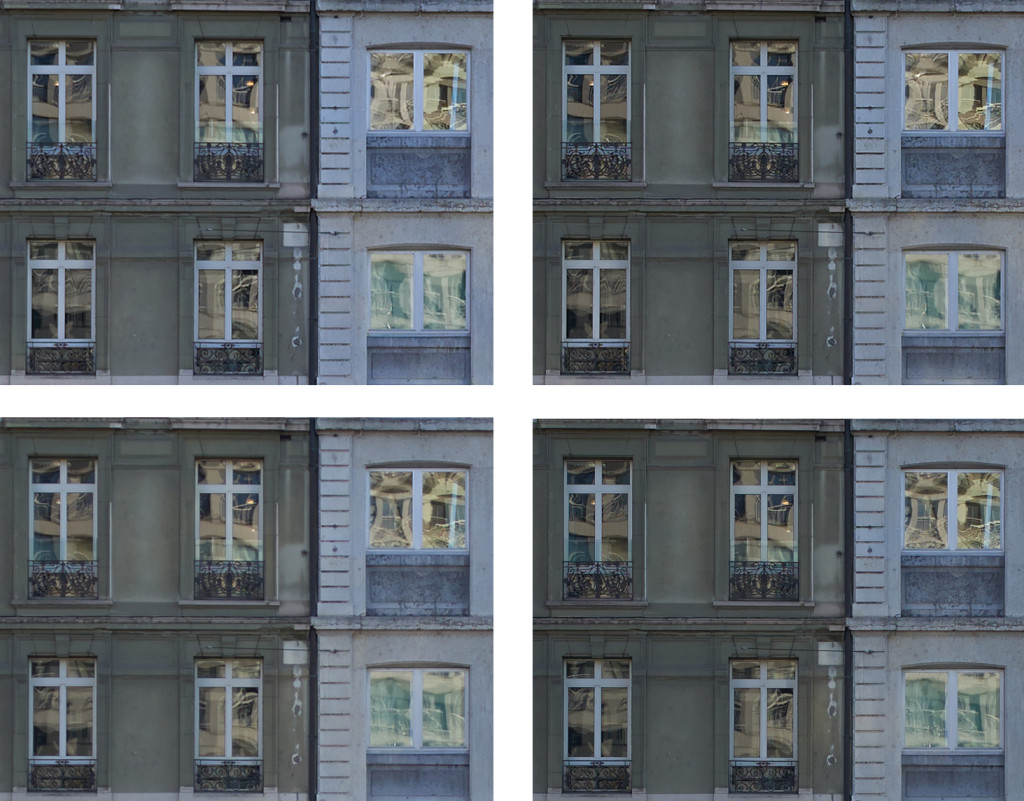
24 mm, 100% center crop. Click to enlarge. Top: VR version, Bottom: non-VR (old). Left: f/2.8, Right: f/5.6
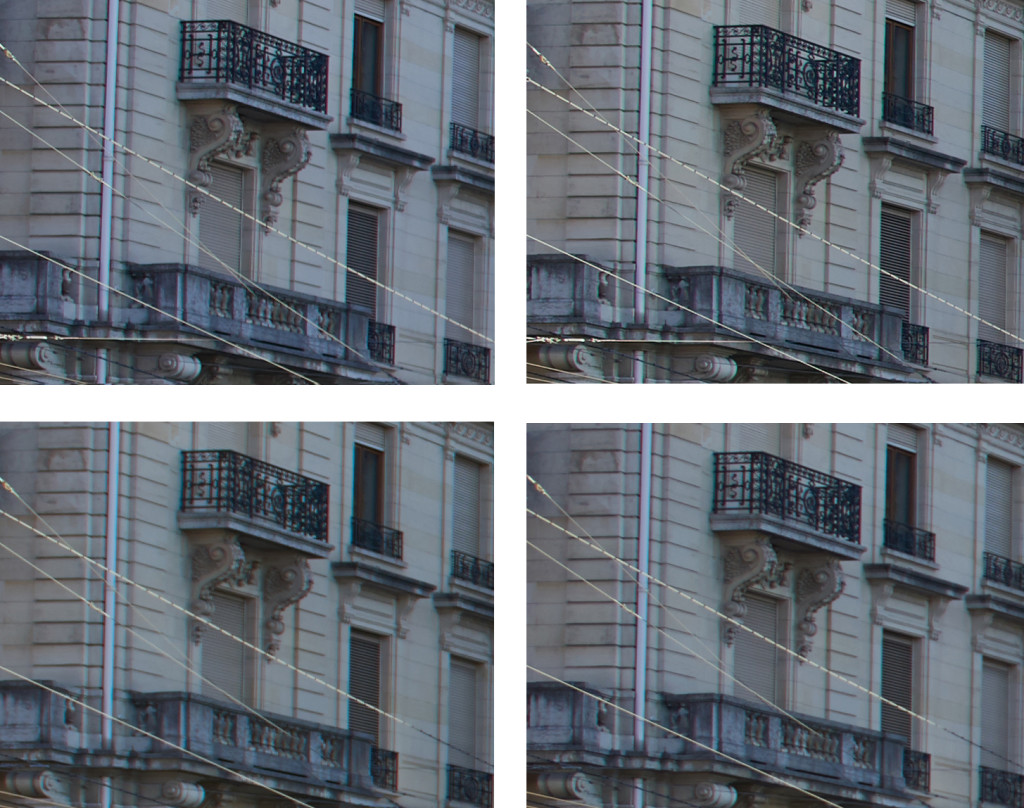
24 mm, 100% corner crop. Click to enlarge. Top: VR version, Bottom: non-VR (old). Left: f/2.8, Right: f/5.6
At 24 mm the E-version lens resolves clearly better, wide open to the mid-range f-stops. The edges are sharper and the center has a tad more bite (micro-contrast) that is difficult to boost in post if it isn’t there to start with. There are some color fringes that can by fixed easily in the raw converter, no worse than old version. At the long end (70 mm) the improvement on the edges is still visible but not as pronounced. And in the center there isn’t a significant difference between the E and G versions, I would even give an edge to the G-version. Obviously, this has been a design choice, trading center resolution against edge to edge sharpness. Good for landscape and architecture, less good for portrait and reportage.
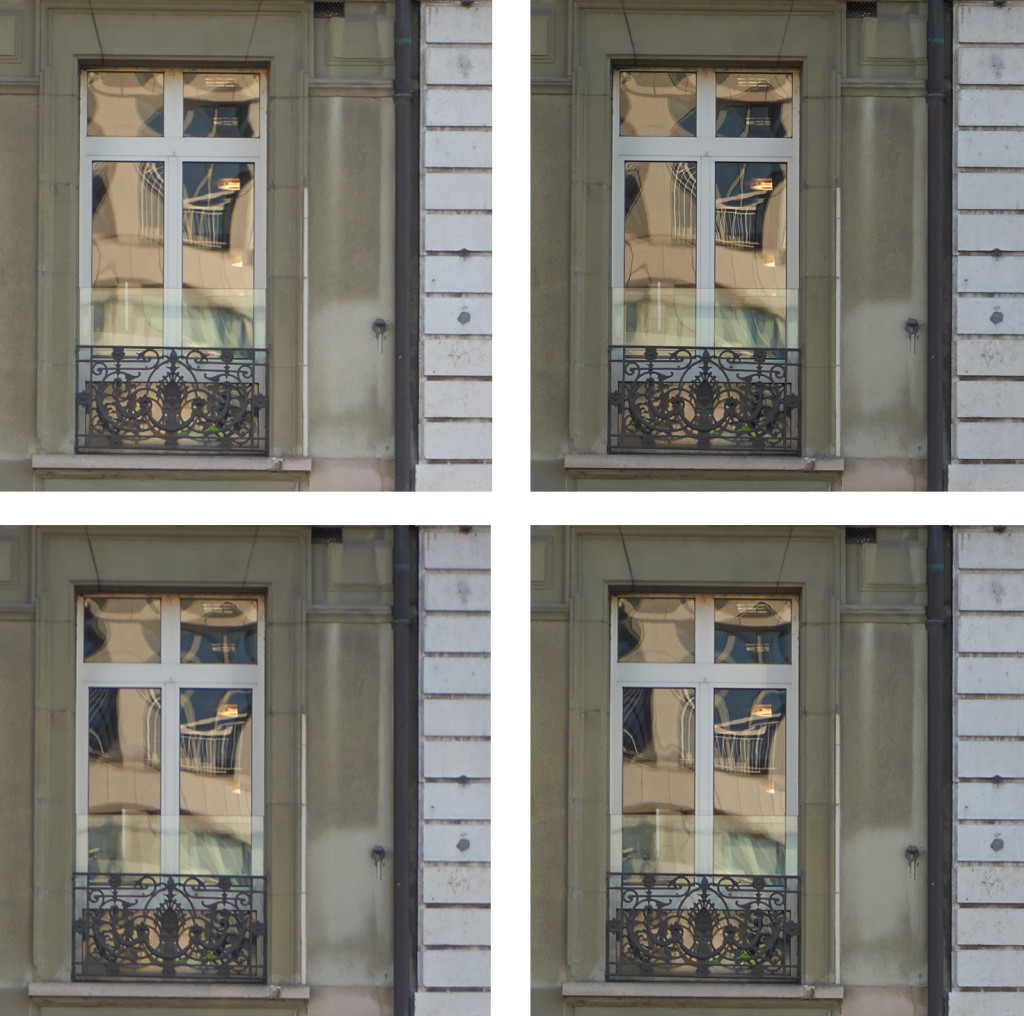
70 mm, 100% center crop. Click to enlarge. Top: VR version, Bottom: non-VR (old). Left: f/2.8, Right: f/5.6
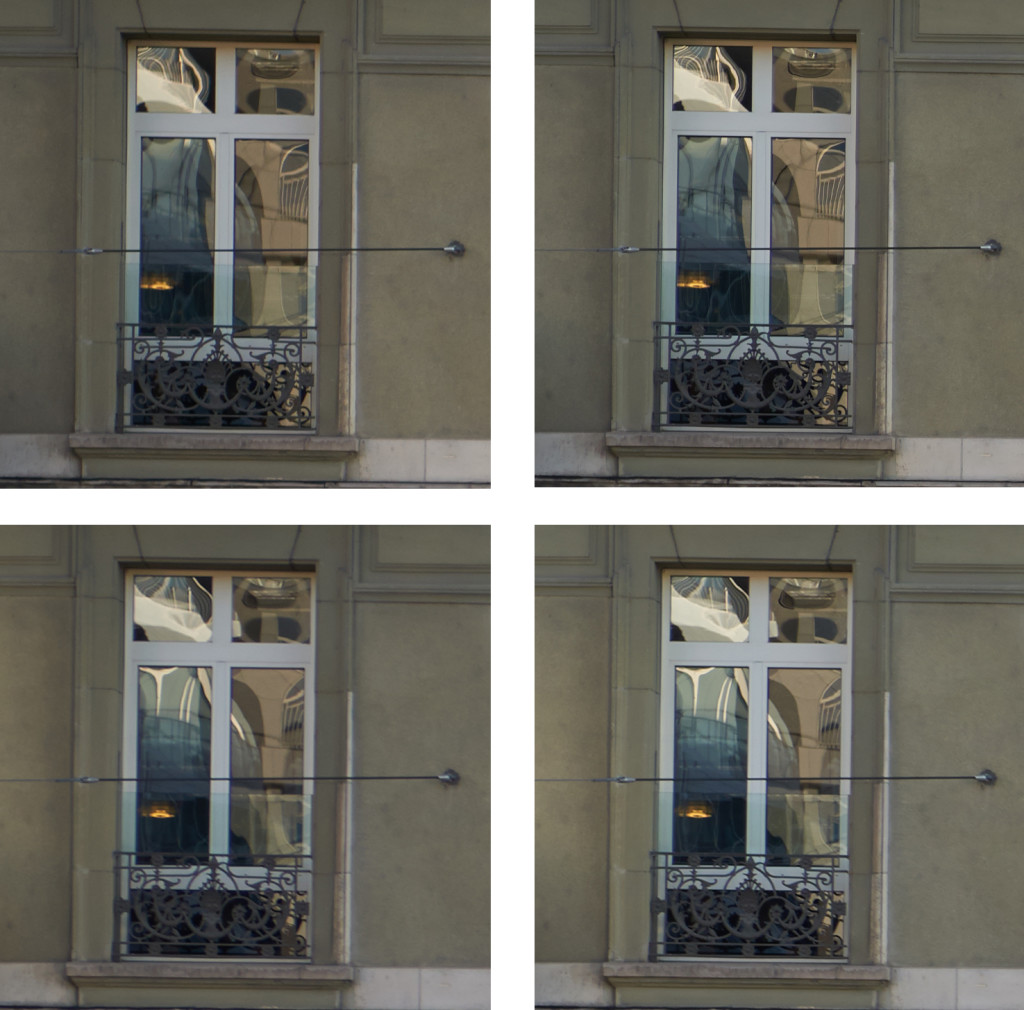
70 mm, 100% corner crop. Click to enlarge. Top: VR version, Bottom: non-VR (old). Left: f/2.8, Right: f/5.6
I made sure not to enable the lens-profile correction in CaptureOne (available in my version for the G-version only) and to exert the usual shot discipline: mirror up and three seconds shutter delay, contrast auto-focus (live-view), and tripod mount (although on a Gitzo Series 1 instead of my standard Series 3). I also checked any negative effect of the VR when the camera is tripod mounted, but didn’t notice any degradation. Sharpening was set to 120, radius 0.8, at threshold 1.0 in CaptureOne.
Some of the images were under-exposed by at least 2/3 of a stop on my D800e, an effect that I first attributed to changing light but then found to come from jumps in the exposure when stopping down. This problem may be related to the electromagnetic diaphragm but possibly be mitigated by a firmware upgrade.
Handheld at 50 mm and 1/30 of a second, there should be a clear advantage for the VR version. Not so. The reason is, that I performed this test at about the close focus distance (CFD). Not being a flower/insect shooter I still appreciate the CFD of 38-41 cm (depending on focal length) for cropped head-shots. But here the new lens does not deliver.
I therefore repeated the tests with different settings and subjects and found this behaviour to be consistent. I focused at open aperture using contrast auto-focus (live view) and checked with 100% magnification on the LCD. VR was disabled, and the usual shot discipline exerted (tripod mount and shutter delay). You can’t do much more in a real-live shooting situation.
The weakness of the E version-lens in resolving power at the CFD shows at all apertures, while there are also signs of focus breathing visible in the rendering of the zoom ring in the upper right sample image (the plane of sharp focus shifts backwards when stopping down). The G version gives consistently better results. The focal point was on the “a” of the Canon logo. I didn’t have the time to check at which focal-plane to subject distance this flaw goes away.
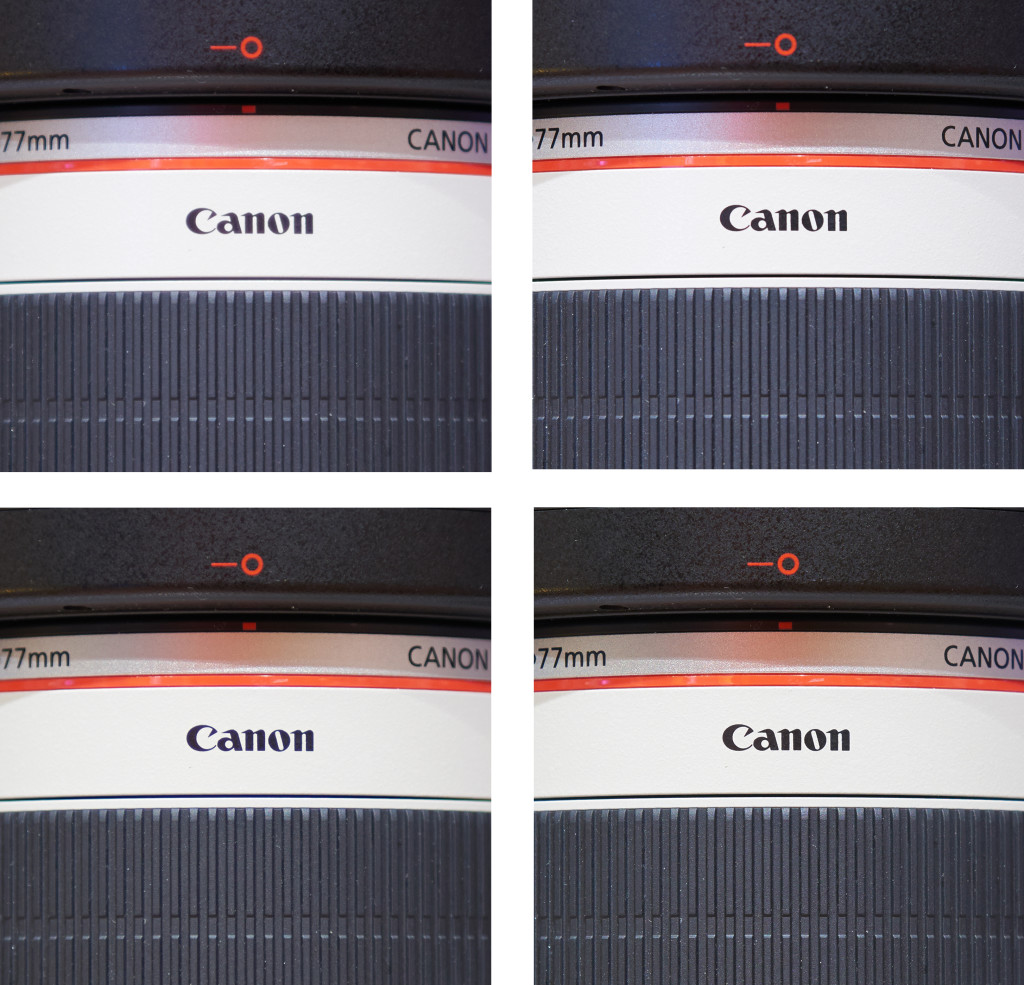
70 mm, close-focusing distance of about 40 cm, 100% center crop. Click to enlarge. Top: VR version, Bottom: non-VR (old). Left: f/2.8, Right: f/5.6. The focal point was on the “a” of the Canon logo.
If you plan to use the lens for head shots (i.e. at the CFD) check it out carefully, there may be a massive sample variation due to the complex 20/16 lens design, or a misalignment in the VR system. There are reasons, other than patent issues, that the high-resolving Zeiss lenses don’t have VR. This new Nikkor zoom is definitely an example how resolution gains from lens design on powerful computers (manifested in MTF curves) can fall off quickly without proper quality assurance. But then, how much would we be prepared to pay.
I finally left without the lens, but with a parking ticket on my car. I would have preferred it the other way around. SR
Update 17.04.2016
I got my hands on another sample of this lens and can confirm the loss of center sharpness at 70 mm focal lengths, for every camera to subject distance below 1.5 meters; exactly the distance for head shots. This lens is therefore best described as portrait soft, useful if you don’t want clinical sharpness. Your wife or girlfriend will appreciate.
2 Comments
Contemplating on getting this lens. Softer at MFD is a bit of an annoyance.
Looks like it has more distortion than previous version, can you confirm?
On the 24mm corner, I’m seeing CA appear at f/5.6 for VR version.
Alex, you have good eyes. There are indeed (green) color fringes at 24 for the VR and non-VR versions. Why only at f/5.6? Because it had escaped me that at f2/8 the chroma correction in CaputureOne was still enabled. This is now corrected.
For the distortions, I cannot confirm for sure, because the levelling of the camera was not identical (I had to walk across the road from the shop to do the tests). But I also photographed a brick wall, where geometric distortions were at least not obviously different for the two lenses.
Thanks for your feedback, Stephan
One Trackback
[…] « Hands on review: AF-S Nikkor 24-70 mm f/2.8E ED VR […]